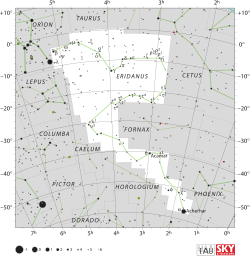Epsilon Eridani
| Observation data Epoch J2000.0 Equinox J2000.0 |
|
|---|---|
| Constellation | Eridanus |
| Right ascension | 03h 32m 55.84496s |
| Declination | −09° 27′ 29.7312″ |
| Apparent magnitude (V) | 3.736 |
| Characteristics | |
| Spectral type | K2V |
| Apparent magnitude (B) | 4.61 |
| Apparent magnitude (V) | 3.73 |
| Apparent magnitude (J) | 2.228 ±0.298 |
| Apparent magnitude (H) | 1.880 ± 0.276 |
| Apparent magnitude (K) | 1.776 ± 0.286 |
| U−B colour index | +0.571 |
| B−V colour index | +0.887 |
| Variable type | BY Dra |
| Astrometry | |
| Radial velocity (Rv) | +15.5 ± 0.9 km/s |
| Proper motion (μ) |
RA: −975.17 mas/yr Dec.: 19.49 mas/yr |
| Parallax (π) | 311.37 ± 0.1mas |
| Distance | 10.475 ± 0.003 ly (3.212 ± 0.001 pc) |
| Absolute magnitude (MV) | 6.19 |
| Details | |
| Mass | 0.82 ± 0.02 M☉ |
| Radius | 0.735 ± 0.005 R☉ |
| Luminosity | 0.34 L☉ |
| Surface gravity (log g) | 4.30 ± 0.08 cgs |
| Temperature | 5,084 ± 5.9 K |
| Metallicity [Fe/H] | −0.13 ± 0.04 dex |
| Rotation | 11.2 days |
| Rotational velocity (v sin i) | 2.4 ± 0.5 km/s |
| Age | 360–720 Myr |
| Other designations | |
| Database references | |
| SIMBAD | The star |
| planet b | |
| planet c | |
Epsilon Eridani (ε Eridani, abbreviated Epsilon Eri, ε Eri), also named Ran, is a star in the southern constellation of Eridanus, at a declination of 9.46° south of the celestial equator. This allows it to be visible from most of Earth's surface. At a distance of 10.5 light-years (3.2 parsecs) from the Sun, it has an apparent magnitude of 3.73. It is the third-closest individual star or star system visible to the unaided eye and is the second-closest star known to host a planet.
The star is estimated to be less than a billion years old. Because of its relative youth, Epsilon Eridani has a higher level of magnetic activity than the present-day Sun, with a stellar wind 30 times as strong. Its rotation period is 11.2 days at the equator. Epsilon Eridani is smaller and less massive than the Sun, and has a comparatively lower level of elements heavier than helium. It is a main-sequence star of spectral class K2, which means that energy generated at the core through nuclear fusion of hydrogen is emitted from the surface at a temperature of about 5,000 K (8,500 °F), giving it an orange hue.
Epsilon Eridani's designation was established in 1603 by Johann Bayer. It may be a member of the Ursa Major Moving Group of stars that share a similar motion through the Milky Way, implying these stars shared a common origin in an open cluster. Its nearest neighbour, the binary star system Luyten 726-8, will have a close encounter with Epsilon Eridani in approximately 31,500 years when they will be separated by about 0.93 ly (0.29 pc).
...
Wikipedia

